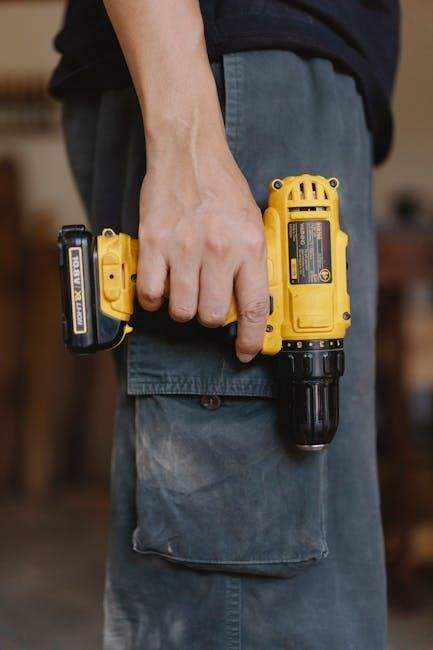Welcome to the D4120 Duct Detector Manual, your comprehensive guide for installing, operating, and maintaining the System Sensor D4120 duct smoke detector. This manual provides essential information to ensure proper functionality, compliance with safety standards, and optimal performance in HVAC systems. Designed for professionals, it covers key features, installation steps, maintenance requirements, and troubleshooting tips to safeguard your system effectively.
By following this manual, you will understand how to integrate the D4120 into your fire safety strategy, ensuring compliance with NFPA 72 and 90A standards. Refer to this guide for detailed instructions and best practices to maximize the detector’s reliability and efficiency in detecting smoke in air ducts.

Overview of the D4120 Duct Smoke Detector
The D4120 duct smoke detector is a photoelectric device designed to detect smoke in HVAC ducts, ensuring early fire detection and system shutdown. It features a 4-wire design for reliable operation and is optimized for air velocities between 100 to 4000 fpm, making it ideal for commercial and industrial applications. The detector’s pivoting housing accommodates both square and rectangular ducts, ensuring versatility in installation. Its advanced technology provides accurate smoke detection, critical for maintaining occupant safety and preventing fire spread in HVAC systems.
Key Features and Functionality
The D4120 duct smoke detector offers advanced features, including a 4-wire photoelectric sensor for accurate smoke detection. Its pivoting housing fits both square and rectangular ducts, ensuring flexible installation. The detector operates within an air velocity range of 100 to 4000 fpm, making it suitable for various HVAC systems. LED indicators provide status updates on power, maintenance, and alarms. The device is UL 268A listed, ensuring compliance with safety standards. It also supports remote testing and interconnection capabilities, enhancing system integration and monitoring. These features ensure reliable performance in detecting smoke and initiating timely responses to potential fire hazards.
Compliance with Safety Standards (NFPA 72 and 90A)
The D4120 duct smoke detector is designed to meet rigorous safety standards, including NFPA 72 and NFPA 90A. NFPA 72 outlines requirements for smoke detectors in HVAC systems, ensuring reliable fire detection and response. NFPA 90A focuses on air ducts, specifying safety protocols to prevent fire hazards. The D4120 adheres to these standards, offering robust protection through accurate smoke detection and compliance with installation and operational guidelines. By meeting these standards, the detector ensures enhanced safety and regulatory compliance in commercial and industrial settings, providing peace of mind for system operators and building occupants.

Installation Guidelines for the D4120 Duct Smoke Detector
Proper installation and operation of the D4120 duct smoke detector require adherence to the manual’s instructions and compliance with NFPA 72 and 90A standards.
Step-by-Step Installation Process
Install the D4120 duct smoke detector by first selecting a location with adequate airflow and accessibility. Mount the detector securely, ensuring it is level and properly seated in the duct. Connect the wiring according to the manual’s instructions, paying attention to the correct terminal connections. Once installed, test the detector to confirm proper operation. Refer to the System Sensor Guide for additional details on spacing, placement, and wiring. Always follow NFPA 72 and 90A guidelines to ensure compliance and safety. Proper installation is critical for reliable performance.
Placement and Wiring Considerations
Ensure the D4120 duct smoke detector is placed in areas with proper airflow to maximize smoke detection accuracy. Avoid installing near high concentrations of dust, moisture, or extreme temperatures. When wiring, follow the color-coded terminals for correct connections, ensuring compliance with NFPA standards. Keep wires away from high-voltage lines to prevent interference. Proper placement and wiring are critical for reliable operation and compliance with safety regulations. Refer to the manual for detailed guidelines on spacing, zoning, and special applications to ensure optimal performance and system integration.

Maintenance and Troubleshooting of the D4120 Detector
Regularly clean the detector’s optics to ensure accuracy. Check for blockages and verify proper wiring. Refer to the manual for troubleshooting common issues like false alarms or power faults.
Regular Maintenance Requirements
Regular maintenance is crucial for the D4120 duct smoke detector to function accurately. Begin by inspecting the detector’s exterior and ensuring it is free from dust and debris. Clean the optics and internal components periodically using a soft, dry cloth to prevent contamination. Check the wiring connections for any signs of wear or damage. Additionally, verify that the air velocity within the duct meets the specified range of 100 to 4000 fpm. Perform functional tests quarterly to ensure the detector responds correctly to smoke simulations. Replace any worn-out parts immediately to maintain reliability. Always refer to the manual for detailed maintenance schedules and procedures to uphold optimal performance and compliance with safety standards.
Common Issues and Diagnostic Solutions
Troubleshooting the D4120 duct smoke detector is essential for maintaining its reliability. Common issues include false alarms, which may result from dirty optics or improper installation. Clean the optics regularly and ensure proper alignment. If the detector fails to alarm, check for low air velocity or blockages in the duct. Verify wiring connections and ensure they are secure. For trouble conditions, refer to the LED indicators: yellow for maintenance, red for alarm, and amber for fault. Address any issues promptly by consulting the manual or contacting a certified technician to restore proper functionality and ensure fire safety. Regular diagnostics prevent unexpected malfunctions.

Technical Specifications of the D4120 Duct Smoke Detector
The D4120 operates with 4-wire photoelectric technology, suitable for air velocities from 100 to 4000 fpm. It meets UL 268A standards and integrates seamlessly with HVAC systems. The detector features pivoting housing for versatile installation and LED indicators for status monitoring. Its design ensures accurate smoke detection, essential for fire safety in duct applications. Refer to the manual for detailed specifications and operational parameters.
Air Velocity Range and Operating Parameters
The D4120 duct smoke detector is designed to function effectively across a wide air velocity range of 100 to 4000 feet per minute (fpm). This broad range ensures reliable smoke detection in various HVAC system configurations. The detector’s photoelectric sensor technology accurately monitors air quality within these parameters, providing consistent performance. Proper installation within these operating limits is crucial for maintaining sensitivity and preventing false alarms. Always refer to the manual for specific guidelines to ensure the D4120 operates within its intended specifications and environmental conditions.
Interconnection and Remote Test Capabilities
The D4120 duct smoke detector supports seamless interconnection with compatible fire safety and HVAC systems, enabling comprehensive integration for enhanced monitoring. Remote testing is a key feature, allowing users to verify detector functionality without physical access, ensuring compliance and system reliability. The detector’s 4-wire design facilitates easy connection to control panels and other safety devices, while its remote test capability minimizes maintenance downtime. This feature ensures the system remains operational and responsive to potential fire hazards, maintaining a high level of safety and efficiency in commercial and industrial settings.

Compliance and Certification
The D4120 duct smoke detector is listed per UL 268A, ensuring compliance with critical fire safety standards. It meets NFPA 72 and 90A requirements, guaranteeing reliability and adherence to industry regulations.
Listing per UL 268A and Other Relevant Standards
The D4120 duct smoke detector is listed per UL 268A, ensuring compliance with fire protection standards for air duct applications. This certification guarantees the detector’s reliability in detecting smoke in HVAC systems, operating within air velocity ranges of 100 to 4000 fpm. Compliance with UL 268A is crucial for meeting local fire codes and regulations, ensuring the device functions optimally in real-world scenarios. Additionally, the detector adheres to NFPA 72 and 90A standards, further enhancing its credibility and performance in fire safety systems.

Integration with HVAC Systems
The D4120 seamlessly integrates with HVAC systems, ensuring enhanced fire safety by working alongside Ruskin UL classified smoke dampers to provide reliable smoke detection in air ducts.
Compatibility with Ruskin UL Classified Smoke Dampers
The D4120 duct smoke detector is designed to work seamlessly with Ruskin UL classified smoke dampers, ensuring a coordinated fire safety response. This compatibility allows for automatic damper closure upon smoke detection, preventing smoke spread in HVAC systems. The integrated system meets UL standards, providing a reliable and efficient solution for commercial and industrial applications. Proper installation and wiring ensure smooth operation, enhancing overall fire safety. Refer to the manual for specific installation and wiring guidelines to maximize compatibility and performance.
Role in Fire Safety and System Integration
The D4120 duct smoke detector plays a critical role in fire safety by detecting smoke in HVAC ducts, enabling early warning systems to activate. Its integration with other safety devices, such as Ruskin dampers, ensures a comprehensive response to potential fires. By monitoring air quality and triggering alarms, it helps prevent smoke from spreading through buildings. This integration enhances overall system efficiency and contributes to a safer environment. Proper installation and maintenance, as outlined in the manual, are essential for optimal performance and reliability in fire safety systems.
The D4120 duct detector manual serves as a complete guide for proper installation, operation, and maintenance. Adhering to these guidelines ensures optimal performance, safety, and compliance with fire protection standards.
Final Thoughts on Proper Usage and Maintenance
Proper usage and maintenance of the D4120 duct smoke detector are crucial for ensuring reliable performance and compliance with safety standards. Regular cleaning of the detector and its components, such as the optical chamber, helps maintain sensitivity and accuracy. Additionally, scheduled inspections and testing, as outlined in the manual, are essential to verify that the device functions correctly under various operating conditions. By adhering to these maintenance routines, users can extend the lifespan of the detector and ensure it provides consistent protection against potential fire hazards in HVAC systems. Consistent upkeep guarantees the D4120 remains a vital component in fire safety strategies.
Importance of Adhering to the Manual Guidelines
Adhering to the D4120 duct detector manual is crucial for ensuring the device functions as intended. Proper installation and maintenance, as outlined, are essential for accurate smoke detection and compliance with safety standards. Deviating from the guidelines can lead to reduced reliability and potential safety risks. Following the manual ensures optimal performance, extends the detector’s lifespan, and guarantees compliance with NFPA standards. Regular inspections and maintenance procedures are vital for maintaining sensitivity and ensuring the detector provides consistent protection against fire hazards in HVAC systems. Always refer to the manual for specific instructions to uphold safety and efficiency.
